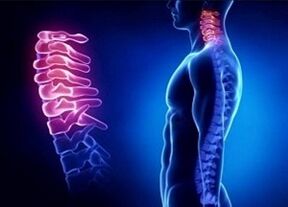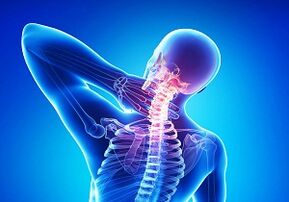
Osteochondrosis of the second degree of the cervix region The pillar is a pathology with which people of different ages are exposed.Many ignore the symptoms of the initial phase of the disease, degenerative and dystrophic processes become more active, pain occurs.
The doctors recommend pay attention to signs of osteochondrosis in the cervix zone.Don't wait until the cartilage between the slices is destroyed, which causes the patient to constantly pain and violate the mobility of the neck.It is important to know that with a severe degree of discogenic pathology, brain hypoxia occurs, dangerous brain disorders and the risk of ischemic stroke increases.
General information
The first degree of the disease is almost asymptomatic: sometimes weak pain in the neck occurs, with palpation you can feel a slight muscle tension.If you start treatment in good time: gymnastics, analgesics, chondroprotectors, vitamins, massage, then it is sufficient to stop the start of degeneration.
In the absence of adequate treatment, the disease is.The second degree of the neck osteochondrosis of the spine is often determined by doctors in patients with headaches, unpleasant sensations in tipping and heading and tilt applications, restrictions on the movements, tensions of the muscles of the neck and shoulders.
Important points at 2 degrees osteochondrosis in the cervix region:
- A crack of the fibrous ring appears, the instability of the cervical spine develops;
- Criminations in the diffusion process, which ensures the full diet of the intervertebral discs, has a negative impact on the condition of the cartilage tissue, the destruction of an important element begins.Violation of the structure of the amortization shelf leads to a decrease in the height of the disc, the vertebrae approach each other, the movements of the head and neck cause pain;
- The pressure on the nerve roots increases, periodic pain occurs.They can be eliminated with analgesics, but unpleasant sensations quickly return after the medicine has expired.
- In the second stage of the disease there is no active compression of vertebral artery, but patients feel different signs of pathology: lethargy, sleep disorder, increased tiredness, decrease in performance level;
- With cervical osteochondrosis, the pain is not only localized in the problem area, but also spreads out on the back of the head, the upper back and shoulders.The progression of the disease against the background of impairment of the innovation of the adjacent departments leads to brain Hebral complications;
- In the absence of treatment in which the effect of negative factors is maintained, the pathology is up to 3 degrees, whereby the fibrous ring and the hyaline laying are actively damaged.The examination is forecasts and intervertebral hernia, constant pain during the friction of the vertebrae, problems with the mobility of the cervix zone and brightly exposed neurological disorders.
The reasons for the development of pathology
Osteochondrosis in the cervix region develops against the background of the following factors:
- Settlement;
- Violation of attitude;
- Calciagum deficiency and vitamins;
- the habit of sitting, bending and bending his head deep;
- long work on the computer;
- genetic predisposition;
- Cervical injuries;
- Excessive load in the zone of the neck, head movements too active;
- improper mineral metabolism for the background of different pathologies;
- Endocrine diseases;
- When fulfilling professional tasks, the head is often thrown back.
Osteochondrosis of the 2nd degree of the Cervical Department of Department according to ICD - 10 M42.
Symptoms of a neck osteochondrosis

The progression of the osteochondrosis of the neck indicates an increase in pain syndrome, a deterioration in the well, unpleasant sensations in the upper back, especially after stress or longer stay in one position.The closer the vertebrae of the other movement, the more active the ligaments seem to keep the optimal position of the retaining rabbit.
Subbluxation vertebrae in combination with a decrease in the influence of the muscle frame improves the symptoms in the affected area.The shift of an elastic laying increased the pain while turning, bending and extending the neck.
The lead of the hard drive changes the correct position of neighboring bone structures, a violation of the attitude appears.If you do not start treatment, continue the uncontrolled absorption of painkillers, then you can soon encounter negative symptoms of 3 degrees Cervical osteochondrosis.
Diagnosis
The treatment is carried out by a vertebrologist.You can also contact a neurologist.
In order to make a diagnosis, the profile specialist illustrates the clinical picture and an anamnesis, prescribes an X rays of the cervix department and MRI.Electromyography is required for severe muscle cramp.If the patient complains of pronounced brain disorders, the Dopplerography of the vessels is required.
Note!After the diagnosis, doctors often find that the patient develops a third degree of illness, but the active progress of the process can still be recognized using instrumental studies.If you do not urgently start treatment, the symptoms of compression of vertebral artery, followed by an impaired cerebral circulation, the development of hypoxia of an important organ, are sometimes in full power.
Effective therapy areas
According to the diagnosis, the doctor recommends eliminating the factors against which the disease progresses.If degenerative is stopped - dystrophic changes in the cartilage, the pathological process will soon influence the bone structures and blood vessels, a set of negative features is displayed.With a severe degree of pathology, it is difficult to stop the process of destroying the cartilage, damage to the fiber ring, doctors show the lead and hernia of the discs.
Medication
The doctor selects several groups of medicines:
- Chondroprotectors.The compositions stop the destruction of the hyalty seal and activate the process of regeneration of cartilage tissue.The course is from 3 months.
- NSAID.Eliminate inflammation in nerve roots, reduce pain and swelling, improve the mobility of the problem area.Medicinal forms: transdermal pavement, capsules, suspensions, tablets, gels, ointments.
- Musorelaxants.They help with painful muscle cramps, make movement easier, relaxing muscle fibers.
- B vitamins.Neurotropic substances are indispensable for the restoration of the transmission of nerve impulses if sensitive structures are stuck against the background of the progress of osteochondrosis.
- Analgesics.With a headache, symptoms against the background of the muscle tension, damage to the intervertebral discs should be used.It is necessary to remember: pain relievers only reduce symptoms, but without the treatment of osteochondrosis, unpleasant sensations in the neck zone, shoulders, headaches and brain diseases will intensify in the course of orthopedic pathology.
- Seastant.Sleep disorder, headache, symptoms in the movements of the head affect the condition of the nervous system negatively.Patients are irritated, insomnia occurs more often.Plant connections and synthetic drugs help: desert tincture, soothing phytosbor, Valerian in tablets and tincture based on roots, mint cooking, lemon balm.
In most cases, the corticosteroids and the drug blockage of the spine in 2 degrees of discogenous pathology are not required: dystrophic and degenerative processes in intervertebral discs, neighboring fabrics are not so active to provoke painful pain.To facilitate the condition of the complex of these medication.It is impossible to use powerful analgesics without prescribing a doctor: With 2 degrees of illness, there are enough preparations with a moderate effects of the exposure.
Other treatment methods
The patient should remember: only with medication is impossible to stop the progression of cervical osteochondrosis.Complex therapy is a prerequisite for restoring the structure of the depreciation disposal, reducing pain, eliminating the muscle cramp and the normalization of the mobility of the neck.
Effective methods:
- Neck massage, including point;
- the use of the Lyapko and the many IPPLITTER KUZNSTSOV;
- Hirudotherapy;
- Acupuncture;
- Physiotherapy: ozokeritic applications, Mudlet, UHF, electrical and phonorophoresis with effective analgesic and anti -inflammatory drugs;
- Physiotherapy exercises and special exercises for osteochondrosis cervical;
- manual therapy;
- Wear a Shant's collar.
Possible complications
Without timely complex therapy, osteochondrosis occurs, brain disorders occur against the background of the compression of the roots of the nerve roots of the vertebral artery.The longer the patient writes a visit to a neurologist or vertebrologist, the more active the intermediate slices are destroyed, the more risk increases the risk of severe brain disorders.

The progression of cervical osteochondrosis often provokes various pathologies and dangerous conditions:
- Dizziness for cervical osteochondrosis in combination with nausea and fainting;
- Ischemic stroke;
- Scoliotic changes;
- the development of a low -oriented cone on the neck, which is popularly referred to as the "widow of the hump";
- Pain syndrome in the neck zone, neck.The discomfort is reinforced by changing the weather conditions and the head movement.
- Jumps in blood pressure;
- Ahead and a more dangerous form of pathology with a break of a fiber ring, light pain syndrome - hernia of the intervertebral disc;
- Heavy headache, including migraine -like nature;
- Daubiness of the cervix region, shoulders, unpleasant tingling, pain and acceptance of the sensitivity of the hands.
To prevent a neck osteochondrosis that prevent the transition of pathology in a serious 3 degrees, the patient must carry out a doctor's bond, take drugs, make gymnastics for the neck, visit massage units, influence the problem area with a transdermal patch.It is important to give up smoking, to eat properly, not to bend, to change the position of the head more often during the working day, but avoid sudden movements.The lack of willingness, the irregularity of procedures, reducing the course of chondroprotectors, more often stress, hypothermia and hypodynamy are factors that improve the risk of progression of cervical osteochondrosis.





















